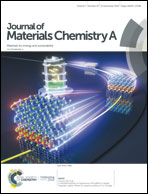High-performance supercapacitor energy storage using a carbon material derived from lignin by bacterial activation before carbonization†
Abstract
The conversion of low-cost renewable lignin could enable the economic fabrication of carbon materials for energy storage devices. However, the traditional activation methods for the production of a lignin-derived porous carbon with a large specific surface area are complex and expensive, and some activators can cause pollution. In this paper, we propose a novel green bacterial activation method for the synthesis of a carbon material with a large surface area of up to 1831 m2 g−1 and abundant micropores and mesopores through a conventional carbonization procedure with a simple bacterial culture process. The transformation of the lignin structure by the bacteria optimizes the pore structure of the derived carbon and promotes graphitization. Consequently, as an electrode in a supercapacitor, the obtained material exhibits a very high specific capacitance (428 F g−1 at 1 A g−1), high cycling stability (capacitance retention of 96.7% after 10 000 cycles at 5 A g−1), and superior rate performance in an aqueous electrolyte. In addition, the symmetric supercapacitor based on the bacteria-activated lignin-derived carbon exhibits a superior energy density of 66.18 W h kg−1 at 312 W kg−1 in an ionic liquid electrolyte system. These excellent features demonstrate the large potential of the developed material for applications in high-performance supercapacitors. Furthermore, the proposed bacteria-activation method can guide a novel bio-modification for material syntheses.



 Please wait while we load your content...
Please wait while we load your content...